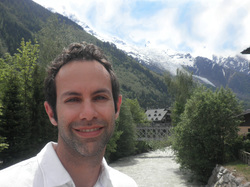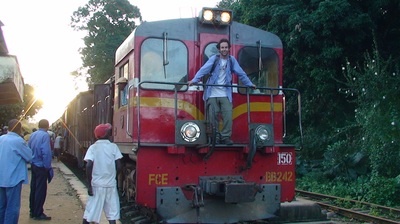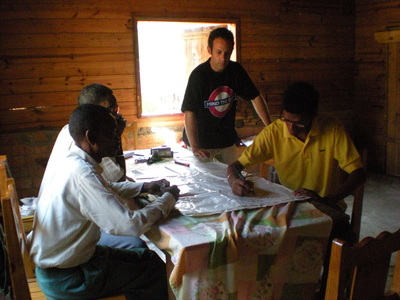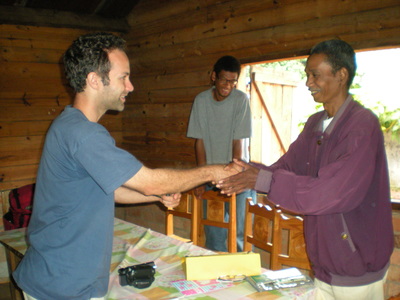Douglas Kolozsvari, Founder, Solutions 2050

Douglas Kolozsvari, Ph.D., founded Solutions 2050 because of his deeply held belief that even the actions of one person can help make livable, sustainable communities through attentive listening and thoughtful facilitation.
His work on environmental sustainability began as an undergraduate when he conducted research on the history of air quality work in the Los Angeles Air Basin and decided to pursue his master's degree in urban planning at UCLA. He was naturally drawn to the transportation sector given its large impact on air quality and quality of life. He conducted research on university transit pass programs and earned a community service award for his efforts preserve UCLA's BruinGo program. Working closely with his advisor, Professor Donald Shoup, he investigated the innovative parking policies put in place in Old Pasadena. Doug and Don co-authored the 2002 publication "Turning Small Change into Big Changes." Doug's thesis on parking benefit districts and parking credits also informed Professor Shoup's seminal publication The High Cost of Free Parking, which has been deemed as one of the most influential urban planning books.
After completing his MA, he led a Safe Routes to School project for the City of Palo Alto that resulted in a number of actions that improved pedestrian and cyclist safety. In 2002, he was hired by SamTrans/Caltrain as an Associate Planner. He worked on these agencies' short- and long-range transit plans, ridership modelling as well as the San Mateo County's Station Access Plan. Doug served as project manager for the East Palo Alto Community-Based Transportation Plan (CBTP), which aimed to improve transportation options in this disadvantaged community. The CBTP was very well received by the funding agency, the Metropolitan Transportation Commission, as well as the City of East Palo Alto's leadership. The mayor even wrote a letter of appreciation for the SamTrans staff who worked on this plan, which helped improve relations between the City and SamTrans. Many of the recommended improvements have since been implemented, including new transit shelters, bicycle and pedestrian improvements, and a community shuttle.
In 2005, Doug joined the Bay Area Air Quality Management District where he reviewed local jurisdictions' environmental documents prepared for their various plans and projects. He wrote nearly 90 comment letters for the Air Pollution Control Officer during his tenure and also represented the Air District at public meetings and workshops.
For more than 15 years, Doug has given numerous invited presentations to municipalities, business groups and nonprofits that have requested his assistance in improving their parking policies. His public speaking engagements eventually led him to return to school to pursue his doctorate in urban planning at the University of Michigan, where he focused on civil society's involvement in the transportation sector. He conducted his dissertation research in Gabon and Madagascar, and ultimately focused on the efforts of civil society organizations in Madagascar that have protected the FCE railway. During his Ph.D. work, he worked from Lyon, France on projects related to transportation accessibility and the use of biofuels for earning carbon credits.
His work on environmental sustainability began as an undergraduate when he conducted research on the history of air quality work in the Los Angeles Air Basin and decided to pursue his master's degree in urban planning at UCLA. He was naturally drawn to the transportation sector given its large impact on air quality and quality of life. He conducted research on university transit pass programs and earned a community service award for his efforts preserve UCLA's BruinGo program. Working closely with his advisor, Professor Donald Shoup, he investigated the innovative parking policies put in place in Old Pasadena. Doug and Don co-authored the 2002 publication "Turning Small Change into Big Changes." Doug's thesis on parking benefit districts and parking credits also informed Professor Shoup's seminal publication The High Cost of Free Parking, which has been deemed as one of the most influential urban planning books.
After completing his MA, he led a Safe Routes to School project for the City of Palo Alto that resulted in a number of actions that improved pedestrian and cyclist safety. In 2002, he was hired by SamTrans/Caltrain as an Associate Planner. He worked on these agencies' short- and long-range transit plans, ridership modelling as well as the San Mateo County's Station Access Plan. Doug served as project manager for the East Palo Alto Community-Based Transportation Plan (CBTP), which aimed to improve transportation options in this disadvantaged community. The CBTP was very well received by the funding agency, the Metropolitan Transportation Commission, as well as the City of East Palo Alto's leadership. The mayor even wrote a letter of appreciation for the SamTrans staff who worked on this plan, which helped improve relations between the City and SamTrans. Many of the recommended improvements have since been implemented, including new transit shelters, bicycle and pedestrian improvements, and a community shuttle.
In 2005, Doug joined the Bay Area Air Quality Management District where he reviewed local jurisdictions' environmental documents prepared for their various plans and projects. He wrote nearly 90 comment letters for the Air Pollution Control Officer during his tenure and also represented the Air District at public meetings and workshops.
For more than 15 years, Doug has given numerous invited presentations to municipalities, business groups and nonprofits that have requested his assistance in improving their parking policies. His public speaking engagements eventually led him to return to school to pursue his doctorate in urban planning at the University of Michigan, where he focused on civil society's involvement in the transportation sector. He conducted his dissertation research in Gabon and Madagascar, and ultimately focused on the efforts of civil society organizations in Madagascar that have protected the FCE railway. During his Ph.D. work, he worked from Lyon, France on projects related to transportation accessibility and the use of biofuels for earning carbon credits.
In 2014, Doug returned to the Air District on an interim basis to backstop open staff positions and to assist with the development of their regional climate protection strategy. He produced greenhouse gas gap analyses reports that included proposed emission reduction measures for both the Waste Management sector and Buildings sector. Doug then took these reports and developed six draft control measures for the Bay Area's 2016 Clean Air Plan/Regional Climate Protection Strategy that is currently being developed. He also reviewed every local climate action plan in the San Francisco Bay Area and developed a database detailing each jurisdiction's proposed emission mitigation measures and quantified reductions.
Whether presenting on parking policies in front of a city council, speaking with the public at an air quality/climate plan workshop in the San Francisco Bay Area or conducting ethnographic research in a rural village in Madagascar, Doug is at home engaging with people of all backgrounds. His passion to improve local livelihood and protect the environment comes from the appreciation that greenhouse gases need to be significantly reduced in the near future if we are to keep global temperatures from rising to 2ºC above pre-industrial times by 2050. The high quality of Solutions 2050's work is a reflection of the seriousness with which this key goal is taken and the understanding that stopping global climate change will require all of our best efforts.
Whether presenting on parking policies in front of a city council, speaking with the public at an air quality/climate plan workshop in the San Francisco Bay Area or conducting ethnographic research in a rural village in Madagascar, Doug is at home engaging with people of all backgrounds. His passion to improve local livelihood and protect the environment comes from the appreciation that greenhouse gases need to be significantly reduced in the near future if we are to keep global temperatures from rising to 2ºC above pre-industrial times by 2050. The high quality of Solutions 2050's work is a reflection of the seriousness with which this key goal is taken and the understanding that stopping global climate change will require all of our best efforts.



